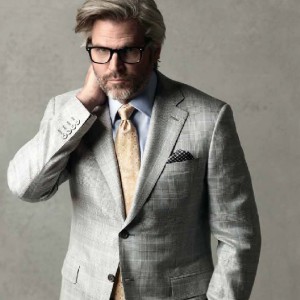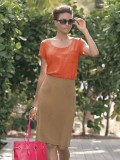
Nordstrom Men’s Fashion. Used with permission. Healthy Aging Magazine tips for men to do it right.
10. Have a full length mirror in your dressing area and before going out look to see that what you are wearing fits properly, that nothing is soiled or torn. Can you button the jacket; is it too snug, how about your trousers; are they too long, too short? Are your shoes shined, hair combed, fingernails clean. Do your socks match your trousers, are buttons missing from any items of apparel? In other words, do you look presentable?
9. If you are wearing a sport jacket or a suit, you must wear a long sleeved dress shirt . Short sleeved shirts are verboten even if it’s 104 in the shade. You can wear it with or without a tie depending on the occasion. With the trend toward more casual apparel, wearing a suit jacket and no necktie has become acceptable, albeit not as professional looking as you would if you were wearing one.
8. Pay attention to your footwear. Your shoes should be as dark as or darker than your trousers. If you are dressing for semi-formal occasion and are wearing a suit, you should be wearing a lace shoe and not a loafer. Keep your shoes in cedar shoe trees when not on your foot as they absorb moisture and keep the shape of the shoe. Shoes should be polished and never scuffed, cracked or dirty. People notice your shoes.
7. You may think your hosiery doesn’t matter, but like everything in your wardrobe it does. Your socks should be the color of your trousers. In other words, brown slacks, brown shoes (and brown socks). Navy trousers, navy socks, and black or cordovan colored shoes. Over the calf socks are best as they stay up. Wool and or cotton socks are equally good. If you are wearing a tuxedo with formal shoes you should wear silk socks.
6. The length of your trousers is crucial. The back of the trouser should not touch the ground. The front of the trouser should however touch the top of the shoe when standing erect. Cuffs or no cuffs, either is acceptable – exception: no cuffs with denim jeans and no cuffs on tuxedo trousers. Your slacks can be pleated or plain front.
5. “Business casual” has no hard definition and thus too often men come dressed improperly for the occasion. What business casual is not is denim jeans, nor is a golf shirt the correct item of apparel for a business setting. Go with a long sleeved collared shirt, and or sweater with cotton or wool slacks. A loafer or tassel shoe (with socks) is right for business casual as is a sport jacket (no tie).
4. Neckties are adornment, nothing more. If you wear one you ought to know how to tie a good knot and secure it at the neck. When you have tied the knot, reach around to the back of the neck and make certain the material is not showing below the collar. Learn to tie a necktie with a dimple in the knot as it presents the tie so well. Silk ties are best as cotton or wool ties just don’t hold a knot very well. Look to see that your necktie has no gravy stains, or is snagged, or worn. Wearing a necktie with the shirt unbuttoned and loose at the neck looks sloppy. Do it right.
3. You wouldn’t think anyone would struggle with this – what buttons to fasten on a suit jacket, (or sport coat). The rule is quite simple albeit frequently violated by the best of men. Fasten all the buttons except the bottom one. In other words, if you are wearing a three- button jacket, button the top two. If the jacket is a two-button model, fasten only the top button. Although they manufacture both four button models and one -button jackets, don’t buy them.
2. Accessories …… watches, rings, bracelets, belt buckles. These can add or detract from your overall appearance. For example, a rubber dive watch is suitable for its purpose but not when wearing a suit. Wedding rings and college class rings are fine, but ditch the pinky ring. A bracelet is fine as is a neck chain when dressing casually, but not for the office.
1. Perhaps the biggest challenge for most men is what to wear, when. Women talk to one another before attending an event and thus arrive suitably attired. Men just guess which can be embarrassing. If the choice is to dress up or dress down, always dress up, as you will never have to apologize for the way you look.
Glen R. Sondag is the author of Anything Other Than Naked, www.anythingotherthannaked.com











